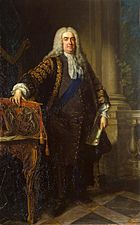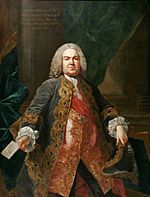Convention of Pardo facts for kids

El Pardo Palace
|
|
| Context | Agree compensation for commercial claims; Commission to establish boundaries between Spanish Florida and Georgia |
|---|---|
| Signed | 14 January 1739 |
| Location | Royal Palace of El Pardo, Madrid |
| Effective | Not ratified |
| Signatories | |
| Parties | |
The Convention of Pardo, also known as the Treaty of Pardo, was an agreement signed in 1739. It was made between Britain and Spain. The main goal was to solve trade problems between the two countries. They also wanted to set clear borders between Spanish Florida and the British colony of Georgia.
This agreement created a special group called a Boundary Commission. Its job was to mark the exact border between Georgia and Florida. Spain also agreed to pay Britain £95,000. This money was to make up for British property that Spain had taken. In return, a British company, the South Sea Company, was supposed to pay Spain £68,000. This payment was for profits Spain believed it was owed from a special trade deal called the Asiento de Negros.
However, the South Sea Company, even though it was owned by the British government, refused to pay. Because of this, both countries rejected the agreement. This disagreement quickly led to a war. The War of Jenkins' Ear began on October 23, 1739.
Why the Treaty Was Needed

In the 1700s, many wars happened because of trade. This was due to an idea called mercantilism. Mercantilism meant that countries believed there was only a limited amount of trade in the world. So, if one country got more trade, another country had to lose some.
The Treaty of Utrecht in 1713 ended a big war called the War of the Spanish Succession. This treaty gave Britain special trade rights with Spain's colonies in the Americas. One right was the Asiento de Negros. This gave Britain the sole right to supply 5,000 slaves each year to Spanish colonies. Another right, the Navio de Permiso, allowed British ships to sell 1,000 tons of goods in places like Porto Bello and Veracruz. But these deals didn't make much money for Britain.
The real money came from goods that were smuggled. These goods avoided customs taxes. Spanish colonists wanted these goods, which created a huge black market. Spanish officials knew they couldn't stop the smuggling. Sometimes, they even used it to their advantage. For example, during a war with Britain from 1727 to 1729, they let French ships carrying illegal goods pass. But they stopped British ships.
Britain accepted that some of their ships and goods would be seized. They saw it as part of doing business. But they worried that France might take over their trade. These worries grew when France and Spain became closer allies in 1733.

In 1729, the Treaty of Seville allowed Spain to search British ships trading with its colonies. In 1731, a British captain named Robert Jenkins claimed a Spanish officer assaulted him, resulting in the loss of his ear. This story became famous later, but the event was mostly forgotten for a while.
Tensions rose again when Britain started the colony of Georgia in 1733. Spain saw this as a threat to Spanish Florida. Florida was very important for protecting Spain's trade routes. In 1738, more British ships were seized. This led to calls for Spain to pay for the losses. British newspapers and pamphlets suggested France was behind these actions. This put a lot of pressure on Robert Walpole, Britain's long-serving leader, to find a solution.
How the Agreement Was Made

Representatives from Britain and Spain met at the El Pardo palace in Madrid in late 1738. By January 1739, they had a basic agreement. Britain had first asked for £200,000 in payment. But they ended up agreeing to £95,000. Spain had wanted unlimited rights to search ships. This was later limited to only ships in Spanish waters.
In return, the British South Sea Company was supposed to pay Philip V of Spain £68,000. This was to settle his share of profits from the Asiento de Negros trade deal. Also, a Boundary Commission would be set up to decide the borders between Georgia and Florida. Sir Benjamin Keene, the main British negotiator, thought this was a good deal. He signed the agreement on January 14.
What Happened Next
The Convention was very unpopular in London. Many British ship captains were angry that their payment claims had been cut by more than half. The South Sea Company was also worried about Spain having any right to search British ships. Within a few months, the situation quickly moved towards war. The agreement became very weak. Those who opposed the Convention even published a list of people who voted for it, showing how much money they made from government jobs.
When the South Sea Company refused to pay the £68,000, Philip V canceled the asiento de Negros trade deal. On July 20, 1739, the British navy sent ships under Admiral Vernon to the West Indies. They reached Antigua in early October. Three British ships attacked La Guaira, a main port in Venezuela, on October 22. Britain officially declared war the next day. This started the War of Jenkins' Ear.
Sir Benjamin Keene was closely linked to Walpole. After Walpole lost power, there was talk of punishing Keene for making the agreement. The War of Jenkins' Ear later became part of a bigger conflict called the War of the Austrian Succession. The original problems that started the war were mostly forgotten by the time the war ended in 1748.
Some issues were finally settled in the 1750 Treaty of Madrid. But illegal British trade with Spanish colonies continued. The Spanish Empire in the Caribbean stayed strong. Spain later used its trade routes and resources to help the American colonists in the American Revolution.
The border issue came up again later between the United States and Spain. This was known as the West Florida Controversy. It was first settled by Pinckney's Treaty in 1796. Then, Spanish Florida was given to the U.S. in the 1819 Adams-Onis Treaty.

